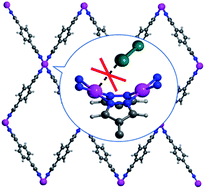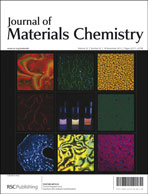Theoretical and experimental characterization of pyrazolato-based Ni(ii) metal–organic frameworks†
Abstract
The structural, electronic, dielectric and vibrational features of two metal–organic frameworks with bispyrazolate ligands are investigated by combining ab initio periodic calculations and experimental techniques. UV-Vis spectroscopy has been used to study the electronic structure, while FTIR spectroscopy to obtain information about the vibrational features of the samples and their adsorptive properties. The examined MOFs contain square-planar Ni(II) nodes bridged either by the 4,4′-bispyrazolato (bpz) or by the 1,4-bis(4-pyrazolato)benzene (bpb) spacers. As expected, they are diamagnetic solids, with Ni(II) in low spin state. This has been confirmed through computations, other magnetic phases being predicted as remarkably less stable. Both materials possess a band gap of ∼3.4 eV and show interesting dielectric properties due to the microporous structure and the low dielectric constant. Although Ni(II) is coordinatively unsaturated, it does not show any specific interaction with the probe molecules tested, as evidenced by FTIR measurements. This unexpected behavior is explained on the basis of computed results. The high stability of the low spin state of Ni(II) in square-planar coordination and a reduced accessibility of the metal sites due to steric effects are considered to be the reasons for the absence of preferential interactions between the metal centers and the probe molecules adopted.


 Please wait while we load your content...
Please wait while we load your content...